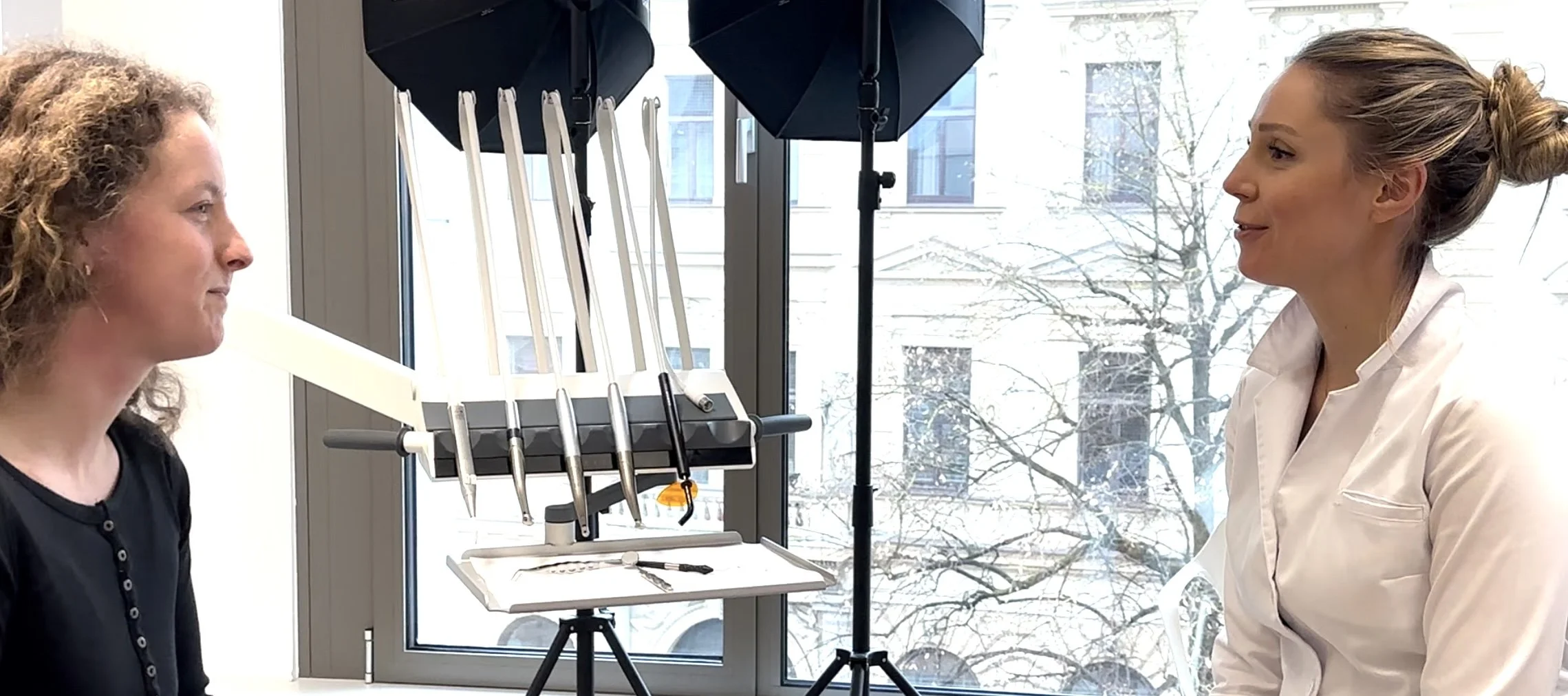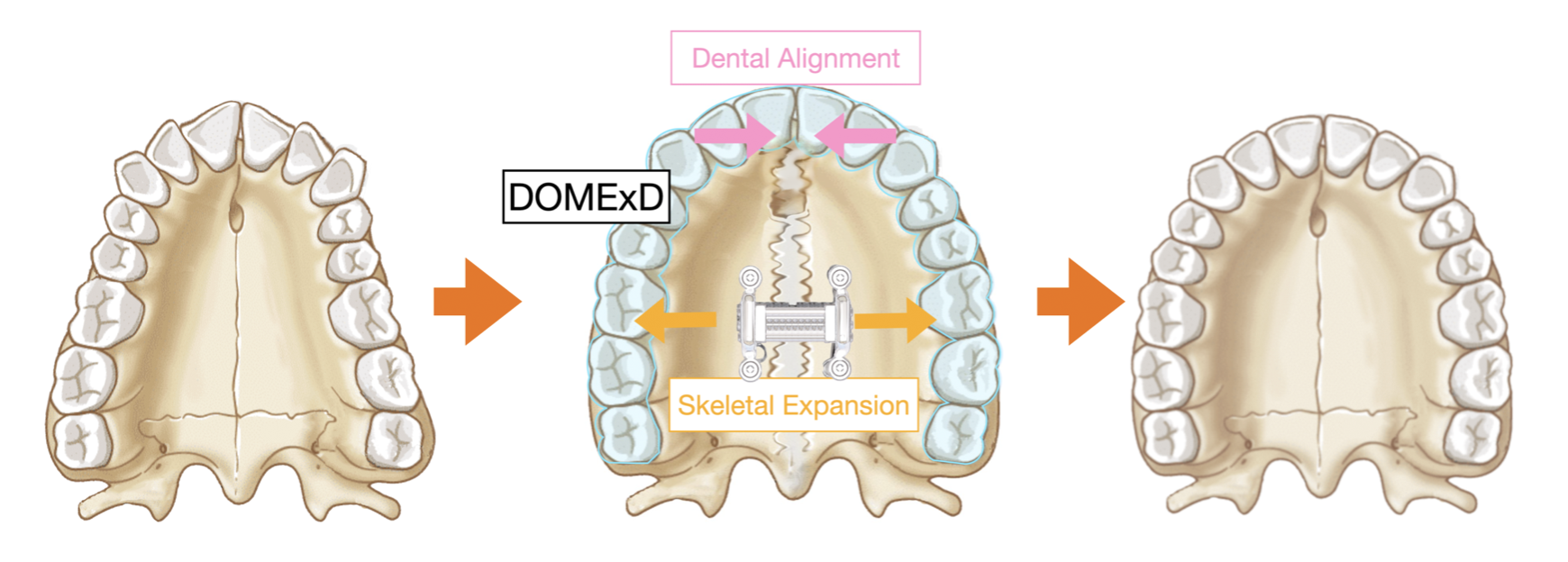Design your Own Maxillary Expansion (DOME)
for Sleep-disordered Breathing
Webinar Series & Live-patient Observation with Hands-on Practice in Vienna
We had our first webinars with participants from 15 different countries!
Recordings are available to our learners. You can still sign up!
See below for the webinar and Vienna immersive experience
This course is designed to share our collective experience from helping patients with sleep-disordered breathing, who are candidates for maxillary expansion. We designed the curriculum for dental and surgical colleagues to optimize sleep breathing health as part of the treatment plan.
There are 2 parts to this course.
Part 1 is a webinar series of 6 lectures that builds foundational knowledge from sleep medicine and orthodontics. You can elect to take only Part 1.
For colleagues ready to move forward, we invite you to join us in Vienna for part 2 - the Immersive Experience (VIE). VIE is a 2 day in-person course that includes live patient demonstrations and a hands-on session to “design your own maxillary expansion (DOME)”. We will share our protocols to get you started!
For colleagues joining us for the Vienna Immersive Experience, the webinar series is required.
DOME Webinar Series
$750.00
Vienna Immersive Experience (VIE)
$4500.00
Learning Objectives
Merge Airway-Focused Orthodontics into Your Practice
Master the Role of Maxillary Expansion in Sleep-Disordered Breathing (SDB)
Diagnose and Plan Maxillary Expansion for SDB Patients
Practice and Observe Live Orthodontic Mini-Screw Placement
Integrate Expander designs and expansion protocols (No Diastema, Clear Aligners)
DOME Webinar Series (6 online lectures with Q/A)
Lecture live on Saturday (45 minutes lecture, 15 minutes Q/A)
8 AM PST (Los Angeles)
11 AM EST (New York)
5 PM CET (Vienna)
Lectures are recorded and available for 30 days.
-
Dr. Stanley Liu
Defining sleep-disordered breathing
Co-morbidity associated with SDB
Mental Fitness and SDB
Treatments for SDB
Dental support for SDB
-
Dr. Claudia Pinter
History review:
Airway Orthodontics is not new
Modern tools:
Osseointegration vs mechanical retention
Insertion torque for mini screw placement
Anatomical considerations for mini screw placements (best insertion sites)
-
Dr. Stanley Liu
Treatment algorithms (medical, surgical, and dental) based on form and function.
Diagnosis and treatment of nasal obstruction
Tonsils : To remove or not?
Hypoglossal nerve stimulation
Maxillofacial treatment, with a formal introduction to transverse maxillary expansion
-
Dr. Claudia Pinter
How does the expansion technique change with patient age
What are determining factors whether patient needs surgical assistance
Latest trends in non-surgical adult maxillary expansion
-
Dr. Stanley Liu
From pediatric to adult patients, what is the outcome of maxillary expansion?
How does maxillary expansion improve the outcome of existing treatments?
Maxillary expansion in children and adults : For and Against? and How to resolve?
-
Dr. Claudia Pinter
Are custom made expanders worth the extra cost?
Pro’s and con’s for appliance first versus bone first approach
How many mini-scews are enough?
Vienna Immersive Experience
VIE - Workshops
-
Dr. Stanley Liu
Hands on evaluation of upper airway resistance syndrome, with a focus on women and children
Interpretation of endoscopic views
Practical guide to treatment of nasal obstruction, and how to collaborate with other specialists (MD’s, ENT’s, Myofunctional therapists)
-
Dr. Stanley Liu
Understand what limits expansion, what structures must give, and how to coordinate nasal, pharyngeal, or other procedures for optimal results.
-
Dr. Claudia Pinter
Practice the full clinical workflow—from anesthesia to torque settings—on phantom heads with step-by-step guidance on guided and freehand techniques
-
Faculty: Dr. Claudia Pinter
Compare appliance-first vs. bone-first approaches, determine patient-specific expansion rates, and avoid midline diastema with strategic planning.
-
Dr. Claudia Pinter
Plan aligner expansion with confidence using Blue Sky Plan software, optimize screw placement, and track long-term results—soon with app support.
-
Dr. Claudia Pinter
Analyze real cases of screw breakage, torus palatinae challenges, and identify when surgical osteotomies are necessary.
VIE - Clinical Experience
-
Young adult with upper airway resistance syndrome, who will be undergoing examination, imaging, and work-up in preparation for DOME
-
Patient with sleep study confirmed sleep-disordered breathing who comes to clinic for DOME.
-
Patient with sleep study confirmed sleep-disordered breathing who comes to clinic for DOME.
The webinar series (Part 1) provides essential background for the in-person course and are registered separately.
Vienna Immersive Experience Schedule
Reception on the evening of Thursday 26th (Optional)
Friday, March 27th, 2026
Morning:
Workshops
Live patients (mini-screw placement, Expander insertion)
Lunch
Workshops
Hands on session (mini-implant placement on typodont, free handed, versus guided)
Dinner (Faculty & Participants)
Saturday, March 28th, 2026
Morning:
Workshops
Live patients (mini-screw placement, Expander insertion)
Lunch
Case discussions
Closing
FAQ
-
Dr. Stanley Liu will demonstrate the surgical cuts involved in DOME for educational purposes. However, the course does not train or authorize dentists to perform surgical cuts in their practice.
-
To enroll in the online lecture series, purchase your access through the website. After payment, the email address will be automatically registered for all webinars. Please note that only registered email addresses can join the webinars. The link cannot be shared.
-
Yes, the online lectures will be recorded and available to you for 30 days. We highly recommend joining live to engage in the Q&A session after the lecture.
-
The no-diastema protocol will be presented in the online lecture series and will be a focus of the in-office course. After completing both the online and in-person parts, you will be able to confidently use the no-diastema protocol with your patients.
-
your role in the treatment of sleep-disordered breathing
how maxillary expansion relates to nasal breathing
risks and complications associated with maxillary expansion and how to avoid/manage them
different treatment algorithms for adult vs pediatric population
outcomes of maxillary expansion for your patients
-
The in-office part is designed to:
build the skills to confidently place mini-implants
observe the workflow in a real patient situation
deepen your understanding of sleep-disordered breathing and maxillary expansion
learn the application of the no-diastema protocol
connect with outstanding colleagues
• • learn directly from Dr. Stanley Liu and Dr. Claudia Pinter in an exclusive setting
-
No. You will receive a TAD Starter Kit for the Benefit Screw (PSM Medical) as part of the course, free of charge.
-
Yes, you can! Please use the contact form to discuss the conditions.
-
We designed this course so that you will be able to start providing maxillary expansion. You will learn the complete workflow, from proper diagnosis to delivering treatment.
-
Yes, this course is for you. In the online webinar series, you’ll learn the basics of orthodontic mini-implants (application, risks, and benefits). In the in-office part, you’ll learn the manual skills to insert them safely and the complete workflow (from planning the mini-implant position in the CBCT using software, to ordering the appliance, placing the mini-implants in a realistic bone model, and mounting an expander onto the screws).
-
Yes, if there are still spots left. You can see the online lecture series as building the foundation to understand sleep-disordered breathing and maxillary expansion. The in-office course builds the skills to deliver treatment with competence and confidence.
-
Yes, there will be 8 CE credits for the online webinar series and 19 CE credits for the in-office course issued by the Austrian Dental Chamber.
-
Each participant will receive:
a TAD Starter Kit worth 540 USD (Sponsor: PSM Medical)
a realistic bone model to practice screw placement
entry fee for Thursday get-together
dinner on Friday evening (Sponsor: ORMCO)
lunch on Saturday (Sponsor: ORMCO)
• • plenty of resources for practical workflow implementation
-
We highly recommend taking the online webinar series before attending the in-office course because the in-office course is reserved for building the skill and focusing on live patient treatment. Content of the lecture series will be assumed.
-
The Benefit Screw System (PSM Medical) will be taught in the course. We believe that a mini-implant with abutment screws allows the highest precision with TAD insertion and provides the most reliable expansion results.
-
You will receive:
a booklet with the most relevant lecture content
a TAD Starter Kit worth 540 USD
workflow images to share the step-by-step process with your team
checklists for you and your team
videos of pre-drilling, mini-implant placement, and expander insertion
the no-diastema protocol
-
You will place mini-implants yourself on a true-to-life bone model mounted inside a phantom head. You will practice placing the mini-implants through a guide and freehand. Because the models are mounted in a phantom head and not sitting on a bench top, you will be trained to orient yourself as you would with a patient lying in your dental chair.
You will also observe Dr. Claudia Pinter placing mini-implants in a patient.











